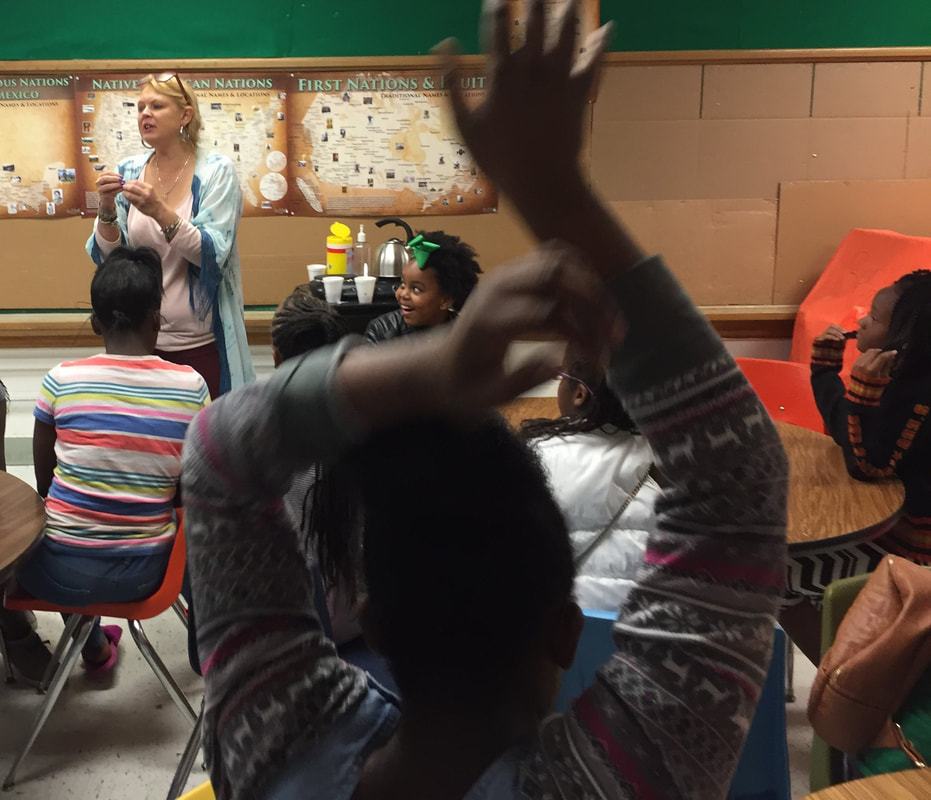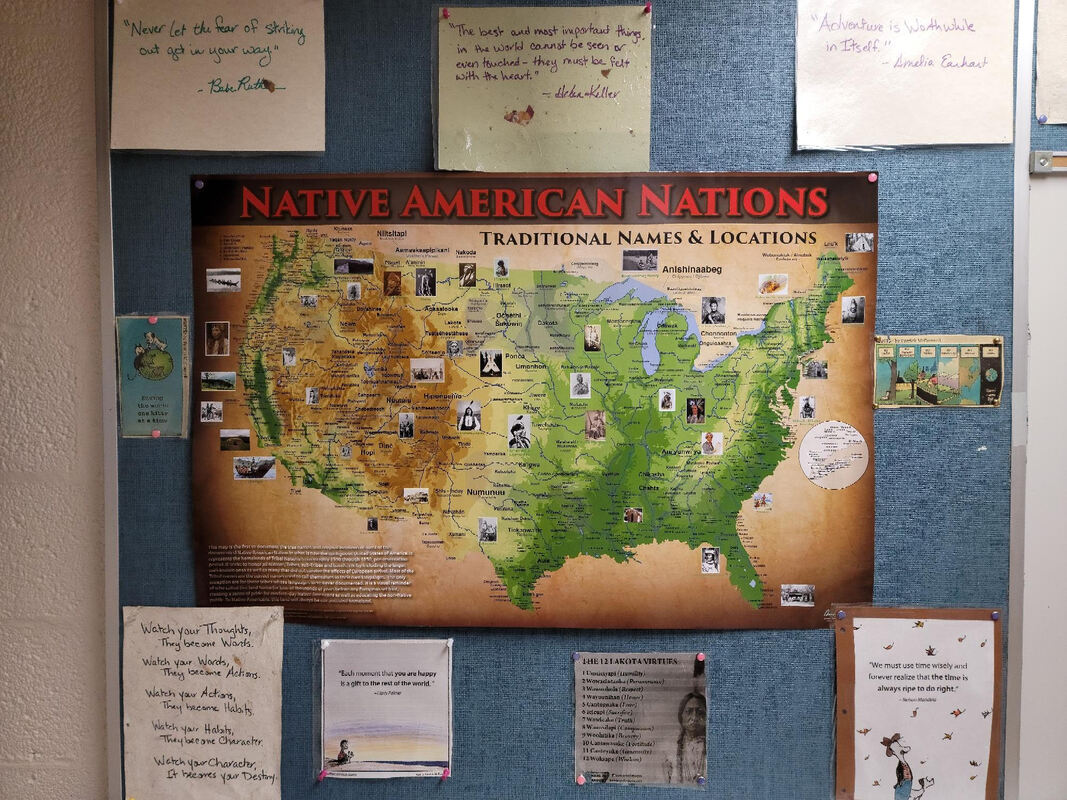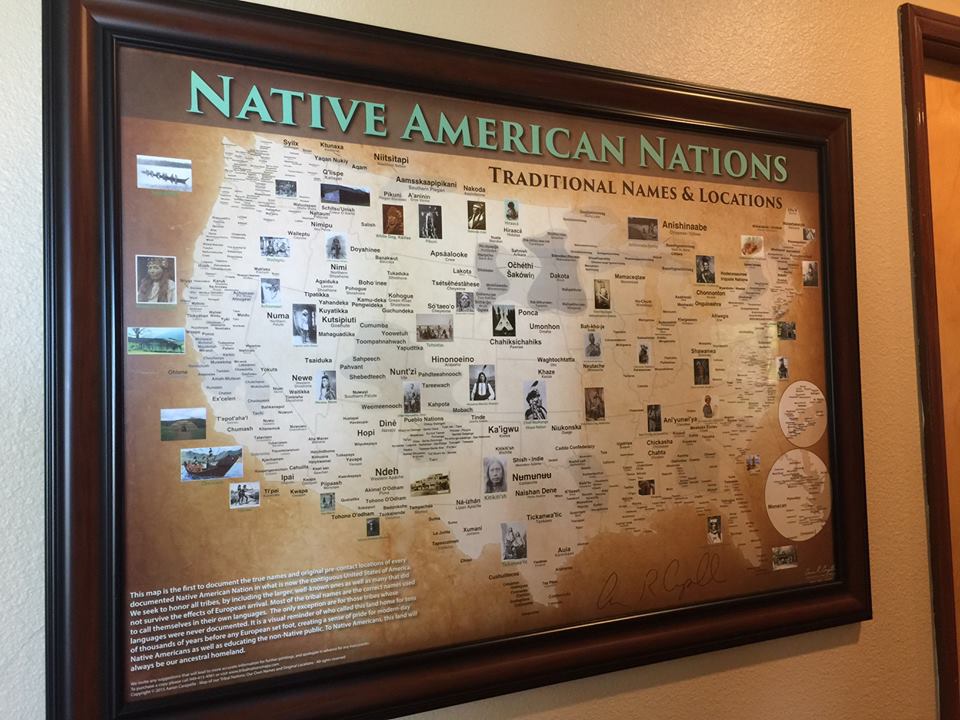INTERVIEW 1- Tara Humphrey - Teacher
1) What-if any- Tribal maps or resources did you use prior to finding out about Tribal Nations Maps?
I didn't or I used basic atlases and common maps. I think I found out about your maps on NPR and included them in the curriculum I was creating.
2) How did finding and using our Tribal maps differ from any resources you had used before?
I feel the students were more interested in the Tribal maps because they could see people vs territory. The maps illustrated the land that was stolen in a way that made history real and important to the student. I think the individuals, culture, and community that was lost is better able to be seen by the young. I also noticed, just the act of hanging them, encouraged regular questions and thoughtfulness even when they were not the particular focus of the day's lesson.
3) What kind of new versions of our maps - or changes to them -would you like to see ?
I took some time to look at your website to see the new maps and products I had not looked at before. You have a lot that is exciting to me.
A recommendation: Maybe a map of not just people, but food. This might be selfish on my part. I teach World Culture through food and art. Teaching cooking illuminates our humanity and culture. I feel understanding where food originated, teaches the student about recycling, commerce, economics, the struggles of globalism, the loss of more culture, history, and science. Plus, we get to eat what we made.
A recommendation: Using QR codes on the maps might be fun for interactive technology. I have also used VR in order to travel inside the classroom and this might be a fun addition.
I also teach specific courses that would love maps from you. Maps for: Transatlantic Slave Trade, Silk Trade, World War 2, the forced occupation and migration of the Native American tribes. (Example: Inside the classroom we learn the dishes and cook along the route of the Transatlantic slave trade, using the maps and food to add to the student's learning)
4) What need is solved by utilizing our maps?
The need to make the genocide, the loss, and history real and relevant to the next generation.
The need to name and to know the past.
The need to understand how we are all connected to each other and how our actions effect the people around us for centuries.
5) How do our products stand out , in your opinion (if at all) ?
They offer a more human look at the people instead of place. It is through them we can see where we live.
6) What are some of the benefits of using Tribal Nations maps, especially for those you show them to?
I think people look at the other maps they see in a different light. They are more aware of the temporary borders and cultures.
7)Would you recommend our maps or other products?
Yes, I recommend them.
8) How do you feel about us offering grade-level-specific Native American books? How about our other products (flags , art canvases, puzzles, postcards, films, banners) - do they offer any value in your teaching setting?
Really excited for the Native American books and would like to read them to my students and my children. I love the Puzzles, as an enrichment teacher, I love using games and fun to teach. The flags are beautiful.
9) Are there any additional comments or recommendations you would like to add or suggest?
I use your maps next to current US maps and the students get another opportunity to sense and acknowledge the land around us.
1) What-if any- Tribal maps or resources did you use prior to finding out about Tribal Nations Maps?
I didn't or I used basic atlases and common maps. I think I found out about your maps on NPR and included them in the curriculum I was creating.
2) How did finding and using our Tribal maps differ from any resources you had used before?
I feel the students were more interested in the Tribal maps because they could see people vs territory. The maps illustrated the land that was stolen in a way that made history real and important to the student. I think the individuals, culture, and community that was lost is better able to be seen by the young. I also noticed, just the act of hanging them, encouraged regular questions and thoughtfulness even when they were not the particular focus of the day's lesson.
3) What kind of new versions of our maps - or changes to them -would you like to see ?
I took some time to look at your website to see the new maps and products I had not looked at before. You have a lot that is exciting to me.
A recommendation: Maybe a map of not just people, but food. This might be selfish on my part. I teach World Culture through food and art. Teaching cooking illuminates our humanity and culture. I feel understanding where food originated, teaches the student about recycling, commerce, economics, the struggles of globalism, the loss of more culture, history, and science. Plus, we get to eat what we made.
A recommendation: Using QR codes on the maps might be fun for interactive technology. I have also used VR in order to travel inside the classroom and this might be a fun addition.
I also teach specific courses that would love maps from you. Maps for: Transatlantic Slave Trade, Silk Trade, World War 2, the forced occupation and migration of the Native American tribes. (Example: Inside the classroom we learn the dishes and cook along the route of the Transatlantic slave trade, using the maps and food to add to the student's learning)
4) What need is solved by utilizing our maps?
The need to make the genocide, the loss, and history real and relevant to the next generation.
The need to name and to know the past.
The need to understand how we are all connected to each other and how our actions effect the people around us for centuries.
5) How do our products stand out , in your opinion (if at all) ?
They offer a more human look at the people instead of place. It is through them we can see where we live.
6) What are some of the benefits of using Tribal Nations maps, especially for those you show them to?
I think people look at the other maps they see in a different light. They are more aware of the temporary borders and cultures.
7)Would you recommend our maps or other products?
Yes, I recommend them.
8) How do you feel about us offering grade-level-specific Native American books? How about our other products (flags , art canvases, puzzles, postcards, films, banners) - do they offer any value in your teaching setting?
Really excited for the Native American books and would like to read them to my students and my children. I love the Puzzles, as an enrichment teacher, I love using games and fun to teach. The flags are beautiful.
9) Are there any additional comments or recommendations you would like to add or suggest?
I use your maps next to current US maps and the students get another opportunity to sense and acknowledge the land around us.
INTERVIEW 2 - Gretchen Brehm - Teacher
1) What-if any- Tribal maps or resources did you use prior to finding out about Tribal Nations Maps?
I have several books (Bury My Heart at Wounded Knee, Native mythology, and some poetry/short story collections) as well as some primary source documents that I have used in my classroom to help teach about native cultures when teaching history.
2) How did finding and using our Tribal maps differ from any resources you had used before?
I put the map up and the kids are amazed to see the different tribes. The details of using both their tribal names and the commonly known names helps the students see why some locations in the US have the names that they do to honor the tribes from there.
3) What kind of new versions of our maps - or changes to them -would you like to see ?
Maybe add a close-up of the Northeast regional names on the Native American nations map since the print is so small in that region around Massachusetts.
4) What need is solved by utilizing our maps?
Your map is helping my students see that there were a myriad of people living and thriving on this continent well before Europeans came here and that we need to do more than just know their names. We need to learn more about the people themselves.
5) How do our products stand out , in your opinion (if at all) ?
Your products stand out by offering details that are often marginalized by textbooks and other resources for teaching about the Native Americans.
6) What are some of the benefits of using Tribal Nations maps, especially for those you show them to?
Most of today's students have little exposure to maps and the colors and details on your map draw them in to look and explore what is on it and then ask questions about who the people were or exclaim about putting together the tribal name with the locations they know.
7)Would you recommend our maps or other products?
Absolutely will be recommending your maps to the other social studies teachers at my school as well as the book and movie recommendations on your site to all the teachers at my school to help us all be better at increasing diversity in our curriculum.
8) How do you feel about us offering grade-level-specific Native American books? How about our other products (flags , art canvases, puzzles, postcards, films, banners) - do they offer any value in your teaching setting?
I love the book recommendations; I already own several of them and have read some of them to my children. I have several of them in my classroom for students to read if they are interested and plan on including more Native books into the new Native studies course I am teaching next year. I will probably find room in my classroom for some of the other items like banners and postcards after school lets out and I rearrange my room.
9) Are there any additional comments or recommendations you would like to add or suggest?
I am so happy to have found you and your map collections to help me open the eyes of my students to all the amazing people that have lived on this continent.
1) What-if any- Tribal maps or resources did you use prior to finding out about Tribal Nations Maps?
I have several books (Bury My Heart at Wounded Knee, Native mythology, and some poetry/short story collections) as well as some primary source documents that I have used in my classroom to help teach about native cultures when teaching history.
2) How did finding and using our Tribal maps differ from any resources you had used before?
I put the map up and the kids are amazed to see the different tribes. The details of using both their tribal names and the commonly known names helps the students see why some locations in the US have the names that they do to honor the tribes from there.
3) What kind of new versions of our maps - or changes to them -would you like to see ?
Maybe add a close-up of the Northeast regional names on the Native American nations map since the print is so small in that region around Massachusetts.
4) What need is solved by utilizing our maps?
Your map is helping my students see that there were a myriad of people living and thriving on this continent well before Europeans came here and that we need to do more than just know their names. We need to learn more about the people themselves.
5) How do our products stand out , in your opinion (if at all) ?
Your products stand out by offering details that are often marginalized by textbooks and other resources for teaching about the Native Americans.
6) What are some of the benefits of using Tribal Nations maps, especially for those you show them to?
Most of today's students have little exposure to maps and the colors and details on your map draw them in to look and explore what is on it and then ask questions about who the people were or exclaim about putting together the tribal name with the locations they know.
7)Would you recommend our maps or other products?
Absolutely will be recommending your maps to the other social studies teachers at my school as well as the book and movie recommendations on your site to all the teachers at my school to help us all be better at increasing diversity in our curriculum.
8) How do you feel about us offering grade-level-specific Native American books? How about our other products (flags , art canvases, puzzles, postcards, films, banners) - do they offer any value in your teaching setting?
I love the book recommendations; I already own several of them and have read some of them to my children. I have several of them in my classroom for students to read if they are interested and plan on including more Native books into the new Native studies course I am teaching next year. I will probably find room in my classroom for some of the other items like banners and postcards after school lets out and I rearrange my room.
9) Are there any additional comments or recommendations you would like to add or suggest?
I am so happy to have found you and your map collections to help me open the eyes of my students to all the amazing people that have lived on this continent.


